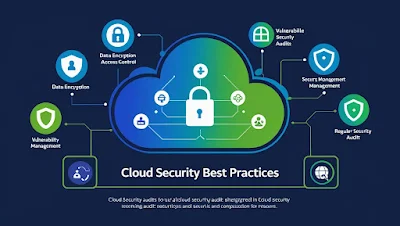☁️ Cloud Security Best Practices: Safeguarding Your Data in the Cloud
Cloud computing has revolutionized the way agencies operate through providing scalable and fee-effective solutions 💡. However, with this advancement comes the important want to make sure the security of data and programs stored within the cloud 🔐. Adopting robust cloud security high-quality practices is critical to defend touchy statistics, maintain regulatory compliance 📜, and safeguard towards ability cyber threats 🛡️. In this blog, we are able to delve into the important thing satisfactory practices that agencies have to observe to enhance their cloud protection posture.
🤝 Understand Your Shared Responsibility Model
When migrating to the cloud, it is critical to apprehend the shared obligation model. Cloud service vendors (CSPs) are answerable for securing the underlying infrastructure, even as clients are responsible for securing their information and packages. Familiarize yourself with the protection responsibilities assigned to both parties to avoid any gaps or misconceptions.
🔑 Implement Strong Access Controls
Implementing strong get entry to controls is fundamental to cloud protection.
✅ Use strong and unique passwords
✅ Enable multi-factor authentication (MFA) for added security
✅ Regularly review and update access privileges to ensure that only authorized personnel can access critical resources.
🔐 Encrypt Data at Rest and in Transit
Data encryption is essential to shield your facts:
-
🔒 Encrypt sensitive data at rest (when stored)
-
📡 Encrypt data in transit (while moving)
Leverage encryption technology provided by your CSP to maximize security.
💾 Regularly Backup and Test Data Recovery
Having a robust backup strategy is essential to recover data in case of a breach, deletion, or corruption.
✅ Test recovery procedures regularly to ensure backup integrity
✅ Store backups in a separate location or use geographically distributed cloud providers to mitigate data loss risks
🌐 Implement Network Security Measures
Utilize key network protections:
-
🧱 Deploy firewalls
-
🕵️ Use Intrusion Detection Systems (IDS) and Intrusion Prevention Systems (IPS)
-
🔒 Segment your network into multiple security zones
-
🚫 Apply network access controls to limit exposure
🧪 Perform Regular Security Audits and Vulnerability Assessments
Consistently evaluate your cloud environment to identify and fix potential security gaps:
✅ Use automated scanning tools
✅ Engage third-party security experts for comprehensive audits
✅ Update and patch software regularly to fix known vulnerabilities
📊 Monitor and Analyze Log Data
Set up a centralized log management system:
-
🔎 Review activity logs frequently to detect suspicious behavior
-
⚠️ Use SIEM (Security Information and Event Management) tools for automation and real-time threat detection
-
🧠 Analyze trends to strengthen future defenses
🧠 Educate and Train Employees
Human error is often the weakest link in security:
-
📚 Conduct regular training sessions
-
🎣 Raise awareness about phishing and social engineering
-
🔐 Emphasize the importance of strong password hygiene
-
📑 Establish clear and easy-to-follow security policies
📝 Regularly Update Security Policies
Keep your cloud security posture current:
-
🔄 Review and update policies periodically
-
📅 Align with the latest industry best practices
-
🧩 Monitor evolving threats and adjust controls accordingly
-
📖 Stay compliant with regulatory and legal requirements






0 Comments